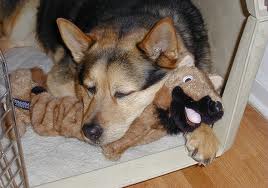
To Crate or Not to Crate: Is there even a Question?
There is some controversy surrounding the idea of crate training your dog or puppy.
But when applied correctly, crate training has been a rewarding and healthy experience for people and their dogs. Here is a list of the positives of crate training a dog or puppy.
The benefits of crate training your dog or puppy are overwhelming:
1) The crate becomes their den – Dogs naturally seek out places that are sheltered and secure for them to rest. A crate becomes this place for them. Over time they will become accustomed to it and use it on their own.
2) Keeps them out of trouble – Even though we would love to be with our dogs all day, many of us can’t. By being able to control where the dog is while you are away, can help eliminate those expensive surprises when you return home.
3) Helps control separation anxiety – For dogs that have anxiety being left alone, putting them in there den/crate is the best way to deal with stress chewing, whining, and general destruction of property. The dog is secure and safe while in its crate and is not worried about you leaving.
4) Helps potty train a new puppy or an older dog with bad habits – Dogs naturally do not soil while they sleep. By introducing a crate you are giving the dog a home that it naturally wants to keep clean. With a regular schedule and consistency a puppy or dog can be trained to go to the bathroom outside and not inside the home or the crate.
5) Helps eliminate unnecessary or all day barking – Some dogs when left to their own devices, love to sit by the door and listen for noises. Unfortunately for some, there are always noises, and a dog barking all day can be a major nuisance. By putting it in its den it helps to keep the dog relaxed and not worried about being over sensitive and territorial while you are away.
When done incorrectly crate training can seem cruel and your dog or puppy will not connect with the crate properly. Putting your dog in the crate without properly introducing and taking the precautions needed for the dog to be successful at crate training can be a stressful experience for your pet and can lead to a negative connection to the crate.
Things to avoid while crate training your dog:
1) DO NOT just stuff the dog in its new home – Gradually introduce the dog or puppy by offering a comfortable experience. Try feeding the dog in the kennel or giving it treats when it first enters the kennel. That way it is having a positive interaction with its new home.
2) DO NOT leave the dog in the crate for extended periods of time when you first begin – Being locked in an unknown place is not a good start. Gradually introduce the dog or puppy to its home by slowly increasing the amount of time that it remains in the crate. In the beginning it may be just 15 minutes, but over time, the dog will be comfortable and happy in its new home and can be left for longer time periods.
3) DO NOT put the kennel in a back room or isolated area – Dogs are social animals. Keep the kennel in a place where you normally are, so the dog is comfortable. Being isolated will make the dog nervous and have a negative feeling for the crate. Try areas like a kitchen or living room in the beginning so the dog can see or hear you.
When done properly there truly is no question: to crate or not to crate. Crate training is an easy and affordable way to eliminate problems with your dog that occur when you are unable to be there to watch or control them. The keys to success are consistency and patience. When you apply both, you will have a happy and well-mannered dog, even when you are away.
